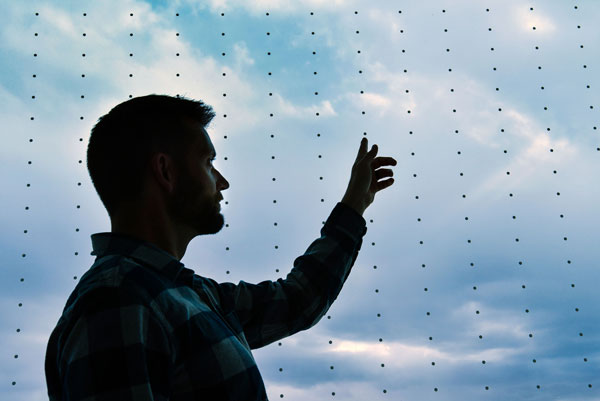Hybrid solution saves energy and birds’ lives

Bird strikes against windows are an all-too-familiar sound. To birds, the transparent glass looks like open space, and between 500 million and 1 billion birds die each year trying to fly through closed windows.
“Birds mistake windows as an escape route,” said Evan Fahy, Sandia ecologist. “They see it as a clear path ahead they can fly through. It’s even harder when there’s vegetation nearby because the vegetation reflects off the glass, confusing the bird more.”
Sandia is solving this problem at one of its high-strike buildings in Technical Area I, where ecology program staff partnered with facilities staff to place adhesives featuring a dot pattern on the window interiors.
“Birds see these patterns and think something is obstructing their way,” said ecologist Matthew Baumann. “This convinces them to avoid the window.”
The solution combines the use of bird-deterrent film on the interior with heat film installed on the exterior of the windows. The team selected the building not only because it was a high-strike building, but its south-facing windows resulted in more heat coming in.
“We wanted to use heat film on the exteriors of the south-facing windows on the building,” said Gail Granot, corporate architect. “The south-facing windows experience a lot of heat gain and increase the internal temperature of the halls on the second and third floors.”
Hotter internal temperatures require more energy to regulate the building’s environment. To reduce solar heat gain, the facilities team installed Exterior Heat Reduction Film.
In the process, the architects conferred with Sandia’s ecologists. Because bird window strikes are such a hazard, the government has increased bird-friendly guidelines for federal buildings.
The two groups wanted to create a win-win solution for both by reducing the hazard to birds while simultaneously reducing energy costs. Strategic planner and project lead Alicia Brown and her team contacted environmental stewardship to determine the feasibility of installing an ultraviolet window film that would also act as a bird deterrent.
Although manufacturers offer different bird-deterrent patterns, the team opted for a solid quarter-inch diameter circular white dot pattern on three-millimeter thick clear vinyl film. The team believed this pattern, which is recommended by the Audubon Society, would deter the birds without obstructing the view for building residents.
“The width and height between the dots is important,” Matthew said. “We don’t want them to obstruct the view, but they needed to be close enough so there is not enough room for smaller birds to think they could fly in between the dots.”
Initially, the team investigated whether their suppliers could provide a film that combined a bird-deterrent pattern with heat-reduction features. It soon became clear this was not an option.
“When I researched these types of film, I couldn’t find a heat film that was also a bird deterrent,” Gail said. “Instead, we came up with a hybrid solution that would meet both our departments’ needs.”
The team inserted the UV film on the exterior of the window and the dotted pattern film on the interior so that it was still visible from the outside.
Jerry Gallegos, strategic planner and energy manager, ran computer models to predict that the UV window film will save 6.31 megawatt hours of electricity annually for the building, or the equivalent of preventing approximately 5,000 pounds of coal from being burned in a year.
The team will collect qualitative data to determine whether bird strikes at the building are significantly reduced. Matthew and Evan are optimistic. Universities and other institutions have seen a marked decrease in bird strikes after installing patterned window adhesives. The facilities team will examine metering data to determine if projected energy models are correct.
The films also have been applied to another key building at Sandia, and the team is looking at applying some type of pattern to the windows of the sky bridge between another pair of buildings.
“We hope to continue working with facilities in this partnership of bird strike mitigations, especially going forward with new buildings,” Evan said.